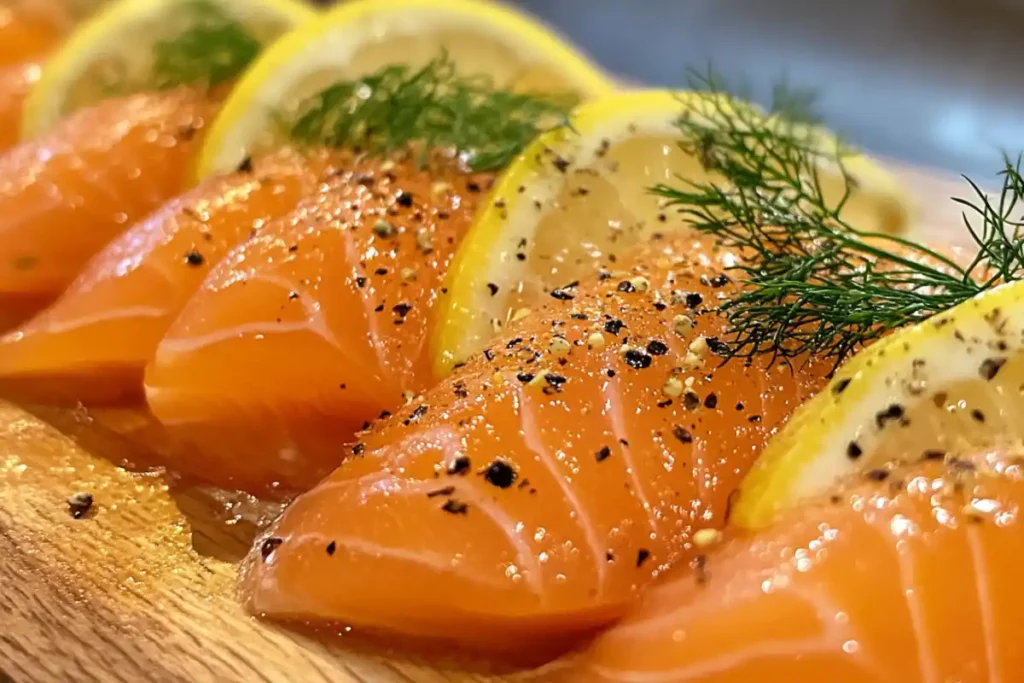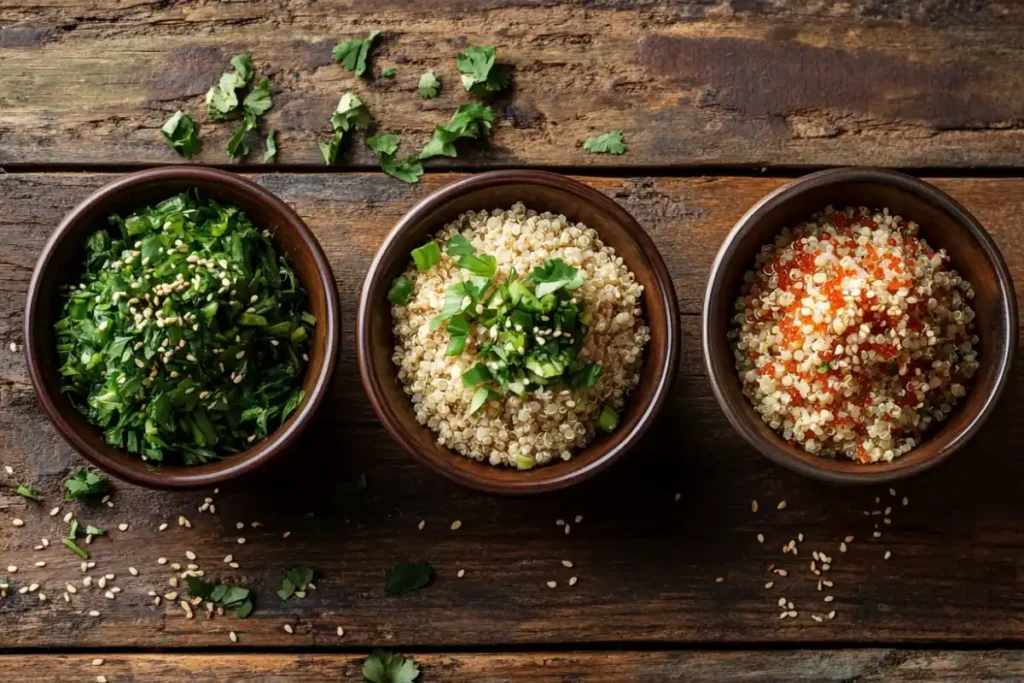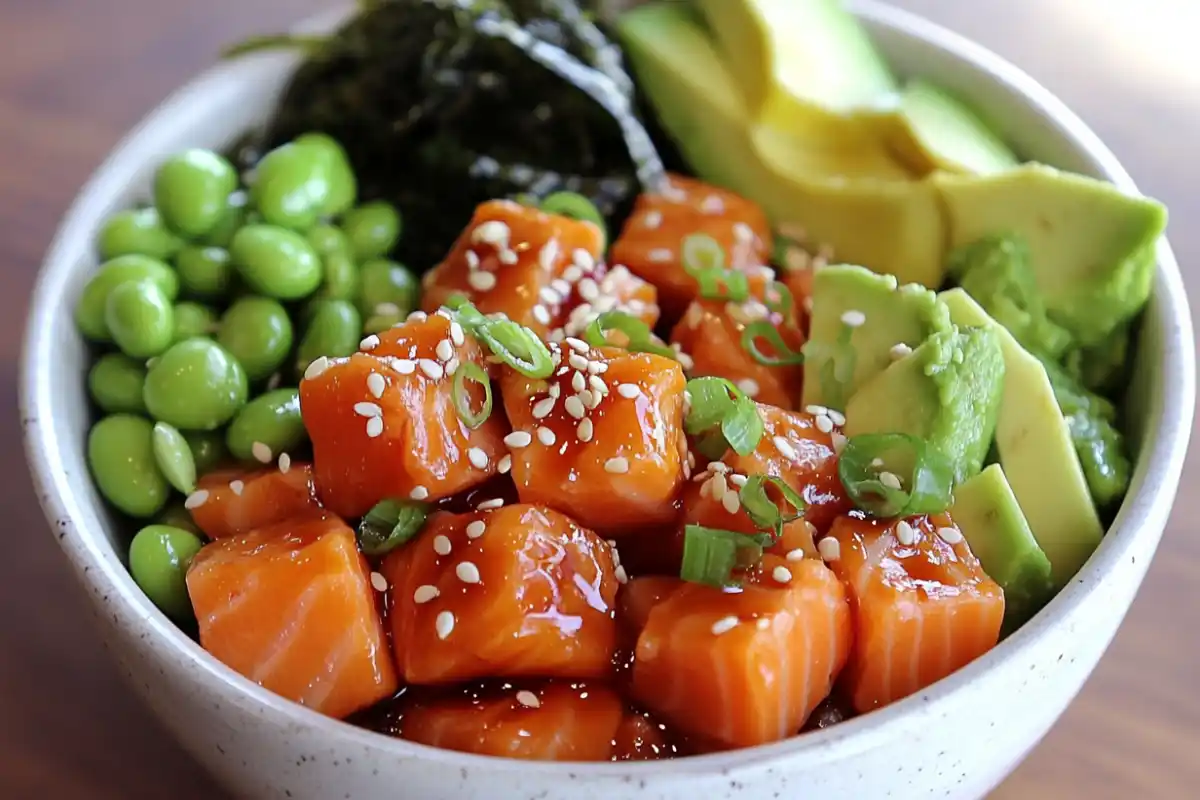Salmon poke bowls have skyrocketed in popularity, becoming a go-to meal for those seeking a fresh, flavorful, and seemingly nutritious dish. But are salmon poke bowls healthy for you? The answer isn’t as straightforward as you might think.
On one hand, poke bowls offer a protein-packed, omega-3-rich meal filled with fresh vegetables and whole grains. On the other, they can be high in sodium, contain hidden calories from sauces, and pose potential risks due to raw fish consumption.
In this article, we’ll break down the nutritional value, health benefits, and potential downsides of salmon poke bowls. Plus, we’ll share expert tips on how to make your poke bowl as healthy as possible. If you’re wondering whether poke bowls fit into your diet, keep reading to find out!
Introduction to Salmon Poke Bowls
What Is a Salmon Poke Bowl?
A salmon poke bowl is a Hawaiian-inspired dish featuring diced raw salmon, served over a base like rice or greens, and topped with various seasonings, vegetables, and sauces. The word poke (pronounced “poh-keh”) means “to slice” in Hawaiian, referring to the way the fish is cut.
Typically, a salmon poke bowl includes:
- Raw salmon (rich in omega-3 fatty acids)
- Rice or greens as a base
- Vegetables like avocado, cucumber, edamame, or seaweed
- Sauces such as soy sauce, ponzu, or spicy mayo
- Toppings like sesame seeds, pickled ginger, or crunchy onions
Origins and Cultural Significance of Poke
Poke originates from Hawaii, where native Polynesians prepared raw fish with salt, seaweed, and kukui nuts. Over time, Japanese influence introduced soy sauce, sesame oil, and other flavors, shaping the modern poke bowl we know today.
Now, poke has become a global food trend, with countless variations. From classic Hawaiian-style bowls to fusion versions loaded with exotic toppings, poke is a customizable meal loved by many.
Why Are Salmon Poke Bowls So Popular?
Salmon poke bowls have gained immense popularity for several reasons:
– Health-conscious appeal – They’re packed with lean protein, healthy fats, and fresh ingredients.
– Customizable & delicious – You can build a poke bowl to suit your taste and dietary needs.
– Fast & convenient – Unlike sushi, which requires precise preparation, poke is easy to assemble.
But while poke bowls are marketed as a healthy meal choice, there’s more to the story. Up next, we’ll dive into the nutritional breakdown of salmon poke bowls to see if they really live up to the hype.
Nutritional Profile of a Salmon Poke Bowl
Are salmon poke bowls healthy for you? It depends on the ingredients. A well-balanced poke bowl offers lean protein, healthy fats, fiber, and essential vitamins. However, high-sodium sauces and calorie-dense toppings can quickly make it less nutritious.
Macronutrients: Protein, Carbohydrates, and Fats
A typical salmon poke bowl provides a balanced mix of macronutrients:
- Protein – Salmon is an excellent source of lean protein, essential for muscle repair and overall health. A single serving (3-4 oz) of raw salmon provides about 22-25 grams of protein.
- Carbohydrates – White rice is the most common base, but it lacks fiber. For a healthier option, choose brown rice, quinoa, or mixed greens to boost fiber intake.
- Fats – Salmon contains heart-healthy omega-3 fatty acids, which can reduce inflammation and support brain function. However, adding mayo-based sauces or fried toppings increases unhealthy fats.
Vitamins and Minerals in a Poke Bowl
Salmon poke bowls are packed with essential vitamins and minerals:
– Vitamin D – Supports bone health and immunity.
– B Vitamins (B12, B6, and Niacin) – Helps with energy production and brain function.
– Iron & Zinc – Crucial for immune health and oxygen transport.
– Potassium & Magnesium – Helps regulate blood pressure and muscle function.
Omega-3 Fatty Acids and Their Health Benefits
Salmon is a top source of omega-3 fatty acids (EPA & DHA), which offer benefits like:
- Heart health – Lowers bad cholesterol (LDL) and reduces the risk of heart disease.
- Brain function – Enhances memory and cognitive function.
- Joint health – Reduces inflammation and stiffness.
However, to maximize these benefits, choose sushi-grade salmon and avoid deep-fried or heavily processed toppings.
Health Benefits of Salmon Poke Bowls
A well-balanced salmon poke bowl offers numerous health benefits, making it a great option for those looking for a nutritious meal. However, certain ingredients can make or break its health value.
Heart Health Benefits from Salmon’s Omega-3s

The omega-3s in salmon play a vital role in reducing inflammation, improving cholesterol levels, and lowering blood pressure. Eating poke bowls regularly may help reduce the risk of heart disease.
Rich in Lean Protein for Muscle Health
Salmon is an excellent protein source, supporting muscle growth and repair. A poke bowl with a lean protein base and fiber-rich veggies keeps you full longer, preventing overeating.
High in Fiber and Antioxidants (With the Right Ingredients)
To get the most out of your poke bowl, choose high-fiber toppings like edamame, seaweed, avocado, and mixed greens. These ingredients:
– Support digestion and gut health
– Stabilize blood sugar levels
– Reduce inflammation with antioxidants
How Poke Bowls Support Weight Management
Are salmon poke bowls healthy for you when trying to lose weight? Absolutely—if customized wisely!
- Opt for a veggie base – Swapping white rice for greens reduces calories while increasing fiber.
- Limit high-calorie toppings – Skip fried onions, tempura flakes, and creamy sauces.
- Control portion sizes – Stick to a single serving of salmon and moderate the amount of rice.
Salmon poke bowls are nutritious and satisfying, but mindful choices will determine whether they help you meet your health goals.
Potential Health Risks and Downsides
While salmon poke bowls are packed with nutrients, they aren’t always the healthiest choice. Some ingredients and preparation methods can turn a nutritious meal into one that’s high in sodium, calories, and potential health risks.
High Sodium Levels from Soy Sauce and Seasonings
One major downside of poke bowls is their high sodium content. Many poke sauces—like soy sauce, ponzu, and spicy mayo—are loaded with salt. Too much sodium can lead to:
- High blood pressure
- Water retention and bloating
- Increased risk of heart disease
🔹 Healthier Alternative: Choose low-sodium soy sauce or swap it for fresh citrus juice or a drizzle of olive oil.
Mercury Levels in Raw Fish: Is It a Concern?
Like many seafood dishes, poke bowls may contain trace amounts of mercury, which can be harmful in large quantities. While salmon is generally lower in mercury than tuna, frequent consumption of raw fish could still pose a risk, especially for:
- Pregnant women
- Young children
- Individuals with compromised immune systems
🔹 Healthier Alternative: Stick to wild-caught salmon and limit intake to 2-3 servings per week.
Risk of Foodborne Illnesses from Raw Salmon
Raw fish always carries the risk of bacterial contamination (such as Salmonella or Listeria). Poor handling or improperly stored fish can lead to food poisoning.
🔹 Healthier Alternative: Ensure you’re eating sushi-grade salmon from a trusted source and store it at safe temperatures.
Added Calories from Toppings and Sauces
Are salmon poke bowls healthy for you if you’re watching your calories? Not always! Heavy toppings like fried onions, crispy wontons, and creamy sauces increase calories without adding much nutrition.
🔹 Healthier Alternative: Stick to nutrient-dense toppings like avocado, edamame, and seaweed.
How to Make a Healthier Salmon Poke Bowl
A poke bowl can be a nutritional powerhouse—if you build it wisely! Here’s how to enjoy one without the excess calories or sodium.

Choosing the Best Base: Brown Rice, Quinoa, or Greens?
The foundation of your poke bowl matters! White rice, while traditional, is high in simple carbs and lacks fiber. Instead, opt for:
– Brown rice – Adds fiber and essential minerals.
– Quinoa – A protein-packed alternative.
– Mixed greens – Low-calorie and nutrient-dense.
Low-Sodium and Healthy Sauce Alternatives
Most poke sauces are high in sodium. Instead of regular soy sauce, try:
- Coconut aminos – A lower-sodium alternative.
- Lemon or lime juice – Adds fresh flavor without salt.
- Sesame oil & rice vinegar – A heart-healthy dressing option.
Best Toppings for Maximizing Nutrition
To keep your poke bowl nutritious and filling, add:
Avocado – Healthy fats and fiber.
Seaweed – A great source of iodine and antioxidants.
Edamame – Packed with plant-based protein.
Avoid fried toppings and limit heavy sauces to keep calories in check.
Portion Control Tips for a Balanced Meal
Even with healthy ingredients, portion size matters. To avoid overeating:
– Stick to one serving of fish (3-4 oz).
– Limit rice to ½ cup and add more veggies.
– Use sauces sparingly—just 1-2 teaspoons is enough.
By following these tips, you can enjoy a delicious and healthy salmon poke bowl that fits into any balanced diet.
For more delicious and healthy seafood recipes, check out our Salmon Poke Bowl Recipe.
Are Salmon Poke Bowls Good for Weight Loss?
If you’re trying to lose weight, you might be wondering: Are salmon poke bowls healthy for you in a calorie-controlled diet? The answer depends on the ingredients and portion sizes.
How Salmon Poke Bowls Fit into a Weight-Loss Diet
Salmon poke bowls can be an excellent choice for weight loss because they’re:
– High in protein – Protein helps you stay full longer, reducing cravings.
– Rich in healthy fats – Omega-3s from salmon support metabolism.
– Loaded with fiber – Choosing a fiber-rich base and toppings improves digestion and satiety.
However, calorie-dense sauces, excessive rice, and fried toppings can sabotage your progress.
Best Ingredients for a Low-Calorie Poke Bowl
To keep your poke bowl weight-loss friendly, try these swaps:
- Base: Choose greens or cauliflower rice instead of white rice.
- Sauces: Use light dressings like lemon juice, rice vinegar, or coconut aminos.
- Toppings: Stick to vegetables, avocado (in moderation), and seaweed for added nutrition.
Common Mistakes That Make Poke Bowls Less Weight-Loss Friendly
– Too much rice – A large scoop can add 200+ calories.
– Heavy sauces – Spicy mayo or eel sauce can be high in fat and sugar.
– Fried toppings – Avoid tempura flakes or crispy wontons.
By making smart choices, a salmon poke bowl can be a delicious, filling, and weight-loss-friendly meal!
Comparing Poke Bowls to Other Popular Dishes
Are salmon poke bowls healthier than other meals? Let’s compare them to some popular alternatives.
Poke Bowls vs. Sushi: Which Is Healthier?
Poke bowls and sushi both feature raw fish, but poke bowls often have more customization options. Here’s how they compare:
- Rice Content: Sushi rolls usually contain more white rice, while poke bowls let you choose healthier bases.
- Protein & Toppings: Poke bowls offer more protein and fresh veggies, making them a better-balanced choice.
- Sodium Levels: Sushi soy sauce and poke dressings can be high in salt, so portion control is key.
🔹 Winner: Poke bowls (if made with smart ingredient choices).
Poke Bowls vs. Salads: Which Is More Nutrient-Dense?
Both meals can be packed with nutrients, but poke bowls provide more protein and healthy fats from fish.
– Poke bowls – Higher in protein and omega-3s.
– Salads – Often lower in calories but may lack healthy fats and protein.
🔹 Winner: Poke bowls (if kept balanced with healthy toppings).
Poke Bowls vs. Grain Bowls: Which Provides Better Energy?
Grain bowls, like quinoa or rice bowls, are high in complex carbs, making them a good choice for sustained energy.
– Grain bowls – Higher in fiber and slow-digesting carbs.
– Poke bowls – Higher in protein and omega-3s but can be customized for balance.
🔹 Winner: Tie – Depends on your energy needs!
No matter your choice, the key is balance and portion control!
FAQs
If you’re still wondering, Are salmon poke bowls healthy for you? you’re not alone! Here are answers to some of the most common questions people ask.
1. Are poke bowls actually healthy or just trendy?
Poke bowls can be a nutritious meal option, but their healthiness depends on the ingredients. A well-balanced poke bowl contains lean protein, healthy fats, and fiber-rich toppings. However, heavy sauces, excessive rice, and fried add-ons can make it less healthy than it seems.
2. How often can you eat poke bowls safely?
It’s safe to eat poke bowls 2-3 times per week, as long as you’re consuming sushi-grade fish from a reliable source. However, eating raw fish too frequently may expose you to mercury and foodborne illnesses. To be safe, vary your protein sources and include cooked seafood or plant-based options occasionally.
3. What are the best protein choices besides salmon?
If you want to mix it up, try:
– Tuna – High in protein but may contain more mercury.
– Shrimp – A great low-calorie, lean protein option.
– Tofu – A fantastic plant-based alternative for vegetarians.
– Chicken – A cooked option for those avoiding raw fish.
4. Can you eat a poke bowl if you have dietary restrictions?
Yes! Poke bowls are highly customizable, making them easy to adapt for various diets:
- Gluten-free: Use tamari instead of soy sauce.
- Low-carb: Swap rice for greens or cauliflower rice.
- Dairy-free: Avoid creamy sauces like spicy mayo.
- Keto-friendly: Choose avocado, salmon, and low-carb toppings.
By making small adjustments, anyone can enjoy a poke bowl that fits their diet!
Conclusion
So, are salmon poke bowls healthy for you? The answer is yes—with the right ingredients and portion control!
A well-balanced salmon poke bowl offers lean protein, omega-3 fatty acids, vitamins, and fiber, making it a nutrient-dense meal. However, excess rice, sodium-heavy sauces, and fried toppings can add unwanted calories and health risks.
To keep your poke bowl as healthy as possible, choose:
– A nutrient-rich base like greens or quinoa.
– Fresh, high-quality salmon for essential omega-3s.
– Wholesome toppings like seaweed, avocado, and edamame.
– Low-sodium dressings like lemon juice or coconut aminos.
Ultimately, poke bowls can be a delicious and nutritious part of any diet—as long as you build them wisely!
Would you like help with a custom poke bowl recipe? Let me know!
